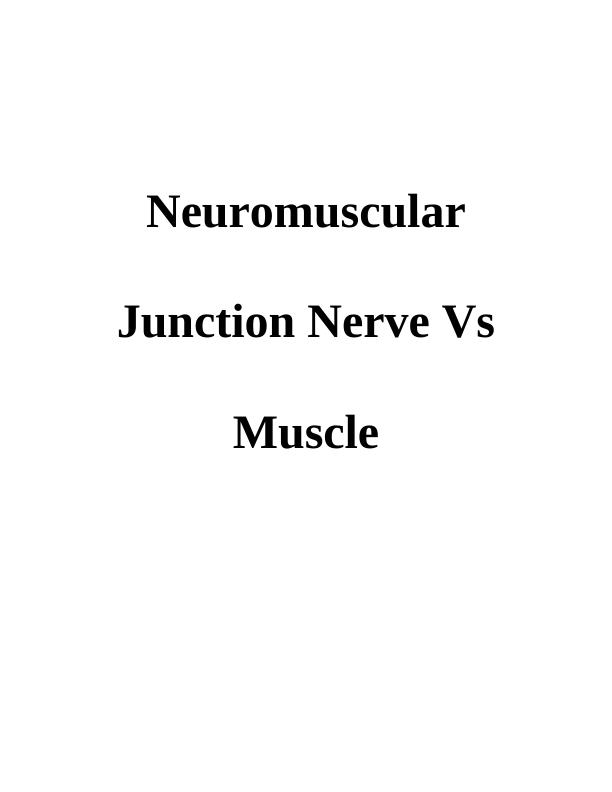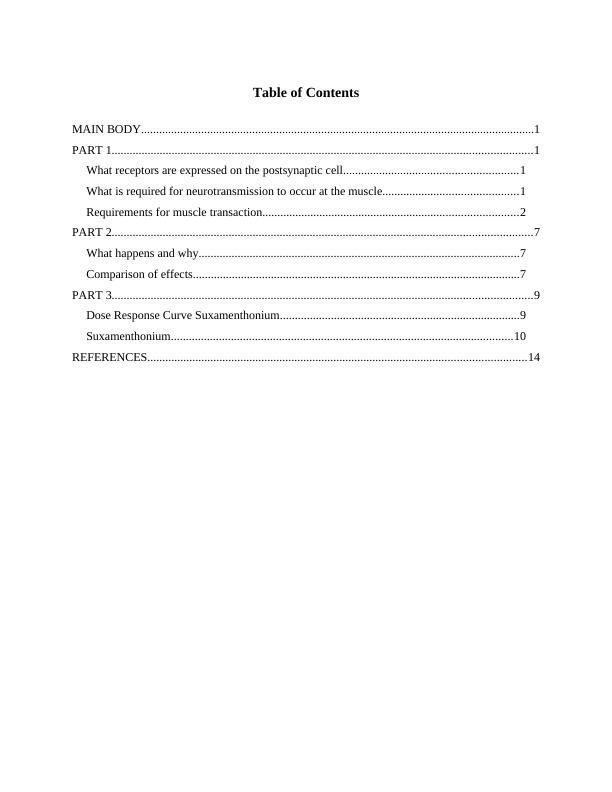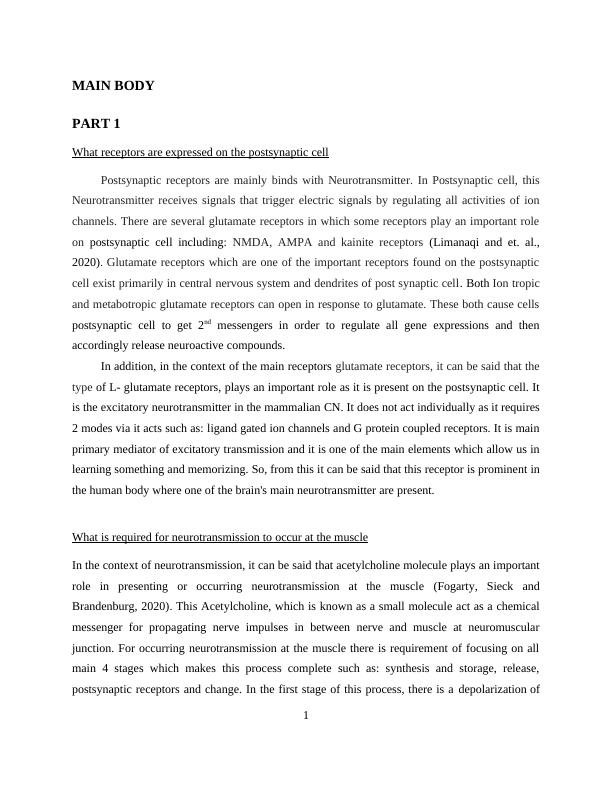Neuromuscular Junction Nerve Vs Muscle
Added on 2023-01-06
16 Pages3580 Words85 Views
Neuromuscular
Junction Nerve Vs
Muscle
Junction Nerve Vs
Muscle

Table of Contents
MAIN BODY...................................................................................................................................1
PART 1............................................................................................................................................1
What receptors are expressed on the postsynaptic cell..........................................................1
What is required for neurotransmission to occur at the muscle.............................................1
Requirements for muscle transaction.....................................................................................2
PART 2............................................................................................................................................7
What happens and why...........................................................................................................7
Comparison of effects.............................................................................................................7
PART 3............................................................................................................................................9
Dose Response Curve Suxamenthonium................................................................................9
Suxamenthonium..................................................................................................................10
REFERENCES..............................................................................................................................14
MAIN BODY...................................................................................................................................1
PART 1............................................................................................................................................1
What receptors are expressed on the postsynaptic cell..........................................................1
What is required for neurotransmission to occur at the muscle.............................................1
Requirements for muscle transaction.....................................................................................2
PART 2............................................................................................................................................7
What happens and why...........................................................................................................7
Comparison of effects.............................................................................................................7
PART 3............................................................................................................................................9
Dose Response Curve Suxamenthonium................................................................................9
Suxamenthonium..................................................................................................................10
REFERENCES..............................................................................................................................14

MAIN BODY
PART 1
What receptors are expressed on the postsynaptic cell
Postsynaptic receptors are mainly binds with Neurotransmitter. In Postsynaptic cell, this
Neurotransmitter receives signals that trigger electric signals by regulating all activities of ion
channels. There are several glutamate receptors in which some receptors play an important role
on postsynaptic cell including: NMDA, AMPA and kainite receptors (Limanaqi and et. al.,
2020). Glutamate receptors which are one of the important receptors found on the postsynaptic
cell exist primarily in central nervous system and dendrites of post synaptic cell. Both Ion tropic
and metabotropic glutamate receptors can open in response to glutamate. These both cause cells
postsynaptic cell to get 2nd messengers in order to regulate all gene expressions and then
accordingly release neuroactive compounds.
In addition, in the context of the main receptors glutamate receptors, it can be said that the
type of L- glutamate receptors, plays an important role as it is present on the postsynaptic cell. It
is the excitatory neurotransmitter in the mammalian CN. It does not act individually as it requires
2 modes via it acts such as: ligand gated ion channels and G protein coupled receptors. It is main
primary mediator of excitatory transmission and it is one of the main elements which allow us in
learning something and memorizing. So, from this it can be said that this receptor is prominent in
the human body where one of the brain's main neurotransmitter are present.
What is required for neurotransmission to occur at the muscle
In the context of neurotransmission, it can be said that acetylcholine molecule plays an important
role in presenting or occurring neurotransmission at the muscle (Fogarty, Sieck and
Brandenburg, 2020). This Acetylcholine, which is known as a small molecule act as a chemical
messenger for propagating nerve impulses in between nerve and muscle at neuromuscular
junction. For occurring neurotransmission at the muscle there is requirement of focusing on all
main 4 stages which makes this process complete such as: synthesis and storage, release,
postsynaptic receptors and change. In the first stage of this process, there is a depolarization of
1
PART 1
What receptors are expressed on the postsynaptic cell
Postsynaptic receptors are mainly binds with Neurotransmitter. In Postsynaptic cell, this
Neurotransmitter receives signals that trigger electric signals by regulating all activities of ion
channels. There are several glutamate receptors in which some receptors play an important role
on postsynaptic cell including: NMDA, AMPA and kainite receptors (Limanaqi and et. al.,
2020). Glutamate receptors which are one of the important receptors found on the postsynaptic
cell exist primarily in central nervous system and dendrites of post synaptic cell. Both Ion tropic
and metabotropic glutamate receptors can open in response to glutamate. These both cause cells
postsynaptic cell to get 2nd messengers in order to regulate all gene expressions and then
accordingly release neuroactive compounds.
In addition, in the context of the main receptors glutamate receptors, it can be said that the
type of L- glutamate receptors, plays an important role as it is present on the postsynaptic cell. It
is the excitatory neurotransmitter in the mammalian CN. It does not act individually as it requires
2 modes via it acts such as: ligand gated ion channels and G protein coupled receptors. It is main
primary mediator of excitatory transmission and it is one of the main elements which allow us in
learning something and memorizing. So, from this it can be said that this receptor is prominent in
the human body where one of the brain's main neurotransmitter are present.
What is required for neurotransmission to occur at the muscle
In the context of neurotransmission, it can be said that acetylcholine molecule plays an important
role in presenting or occurring neurotransmission at the muscle (Fogarty, Sieck and
Brandenburg, 2020). This Acetylcholine, which is known as a small molecule act as a chemical
messenger for propagating nerve impulses in between nerve and muscle at neuromuscular
junction. For occurring neurotransmission at the muscle there is requirement of focusing on all
main 4 stages which makes this process complete such as: synthesis and storage, release,
postsynaptic receptors and change. In the first stage of this process, there is a depolarization of
1

the terminal membrane and then activation of voltage-gated channels. In next stages it changes in
the conformation of docking proteins.
So, it can be said that this neuromuscular junction is a chemical synapse between muscle fibre
and motor neuron. This junction plays an important role in neurotransmission as for transmitting
a signal it allows the motor neuron to the muscle fibre. When an AP occurs then range or amount
of neurotransmitter increases and it releases in nerves innervating skeletal muscles. The main
characteristic of small molecule and synaptic junction in the process of neurotransmission is
there is a distinct separation between postsynaptic and presynaptic membrane and the space
between both synaptic tell us that there is an intermediary signalling mechanism.
Requirements for muscle transaction
There is requirement of mainly 3 things for muscle contraction and muscle transaction such as:
There is requirement of neural stimulus, there must be calcium in muscle cells for better
transaction and ATP is also required for providing energy to muscle. So, from this it can clearly
be said that calcium ions play an important role as muscle contraction and transaction cycle is
triggered by calcium ions which binds to protein complex troponin (Maggio and et. al., 2019).
Both Na2+ and Ca2+ are required in muscle transaction and contraction for membrane
depolarisation. It makes all Ions to move through membrane and leads to effective and proper
impulsive muscle transaction. There are some steps by which muscle contraction and
requirement for muscle contraction or transaction can be known in a detailed manner such as:
generation of action potential, Ca2 released, bonding of Ca2 with troponin then myosin cross
bridges attach and detach. After those muscles started contracting then Ca2+ removed which
shifts active filaments to its original position. So, from these all steps of muscle contraction it can
be said that calcium Ions or Ca2+ is one of the important element which provides element and
elasticity in this process.
2
the conformation of docking proteins.
So, it can be said that this neuromuscular junction is a chemical synapse between muscle fibre
and motor neuron. This junction plays an important role in neurotransmission as for transmitting
a signal it allows the motor neuron to the muscle fibre. When an AP occurs then range or amount
of neurotransmitter increases and it releases in nerves innervating skeletal muscles. The main
characteristic of small molecule and synaptic junction in the process of neurotransmission is
there is a distinct separation between postsynaptic and presynaptic membrane and the space
between both synaptic tell us that there is an intermediary signalling mechanism.
Requirements for muscle transaction
There is requirement of mainly 3 things for muscle contraction and muscle transaction such as:
There is requirement of neural stimulus, there must be calcium in muscle cells for better
transaction and ATP is also required for providing energy to muscle. So, from this it can clearly
be said that calcium ions play an important role as muscle contraction and transaction cycle is
triggered by calcium ions which binds to protein complex troponin (Maggio and et. al., 2019).
Both Na2+ and Ca2+ are required in muscle transaction and contraction for membrane
depolarisation. It makes all Ions to move through membrane and leads to effective and proper
impulsive muscle transaction. There are some steps by which muscle contraction and
requirement for muscle contraction or transaction can be known in a detailed manner such as:
generation of action potential, Ca2 released, bonding of Ca2 with troponin then myosin cross
bridges attach and detach. After those muscles started contracting then Ca2+ removed which
shifts active filaments to its original position. So, from these all steps of muscle contraction it can
be said that calcium Ions or Ca2+ is one of the important element which provides element and
elasticity in this process.
2

End of preview
Want to access all the pages? Upload your documents or become a member.
Related Documents
The Advantages of Chemical Synapses | Studylg...
|5
|889
|80
Anatomy and Physiology Study Materiallg...
|9
|2577
|381
Mechanism of Action of Botox: A Cellular Perspectivelg...
|5
|1205
|421
Assignment on Neurotransmitterslg...
|4
|401
|178
Role of Neurotransmitters in Nerve Transmissionlg...
|10
|875
|66
Article On Acetylcholine by Otto Loewilg...
|3
|633
|48
